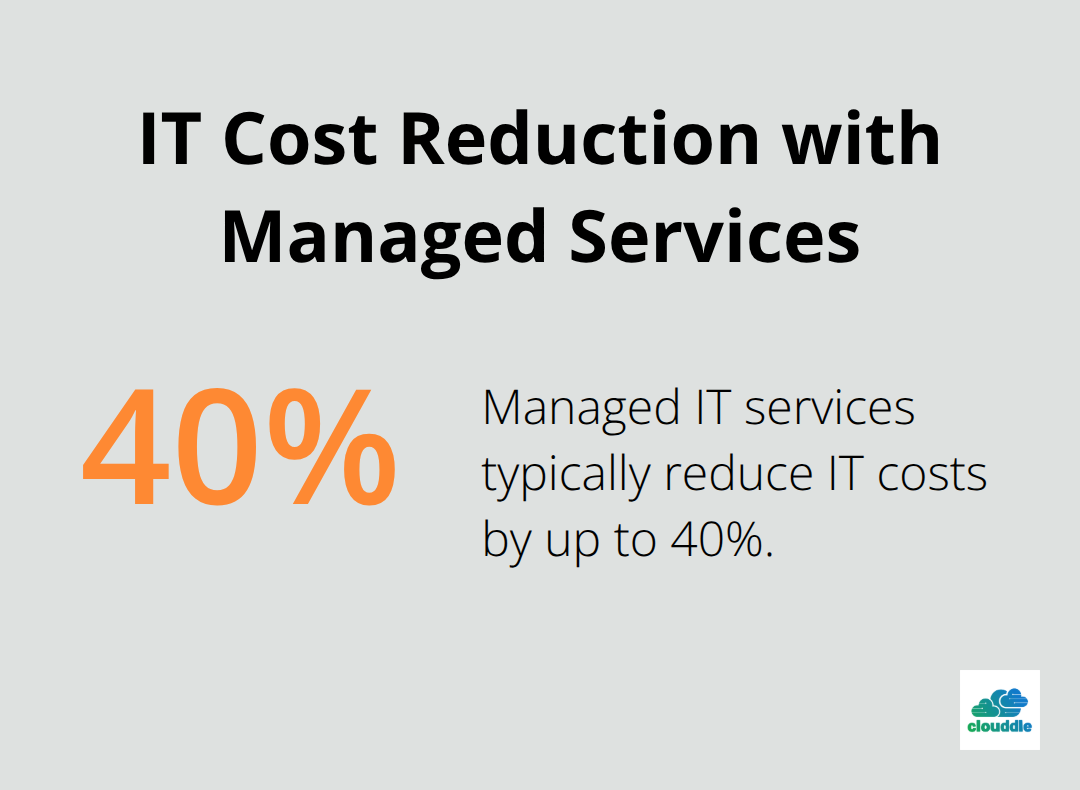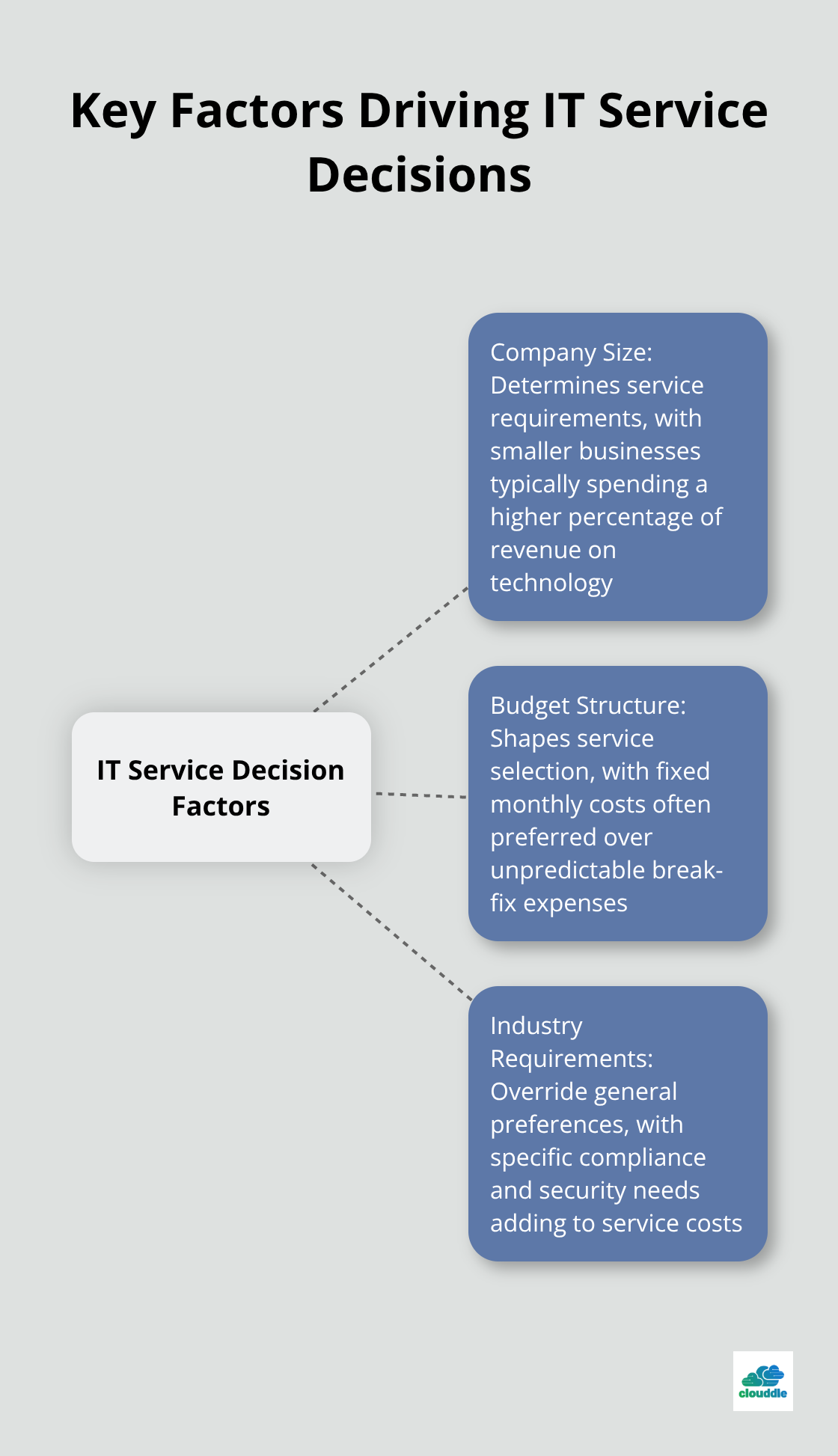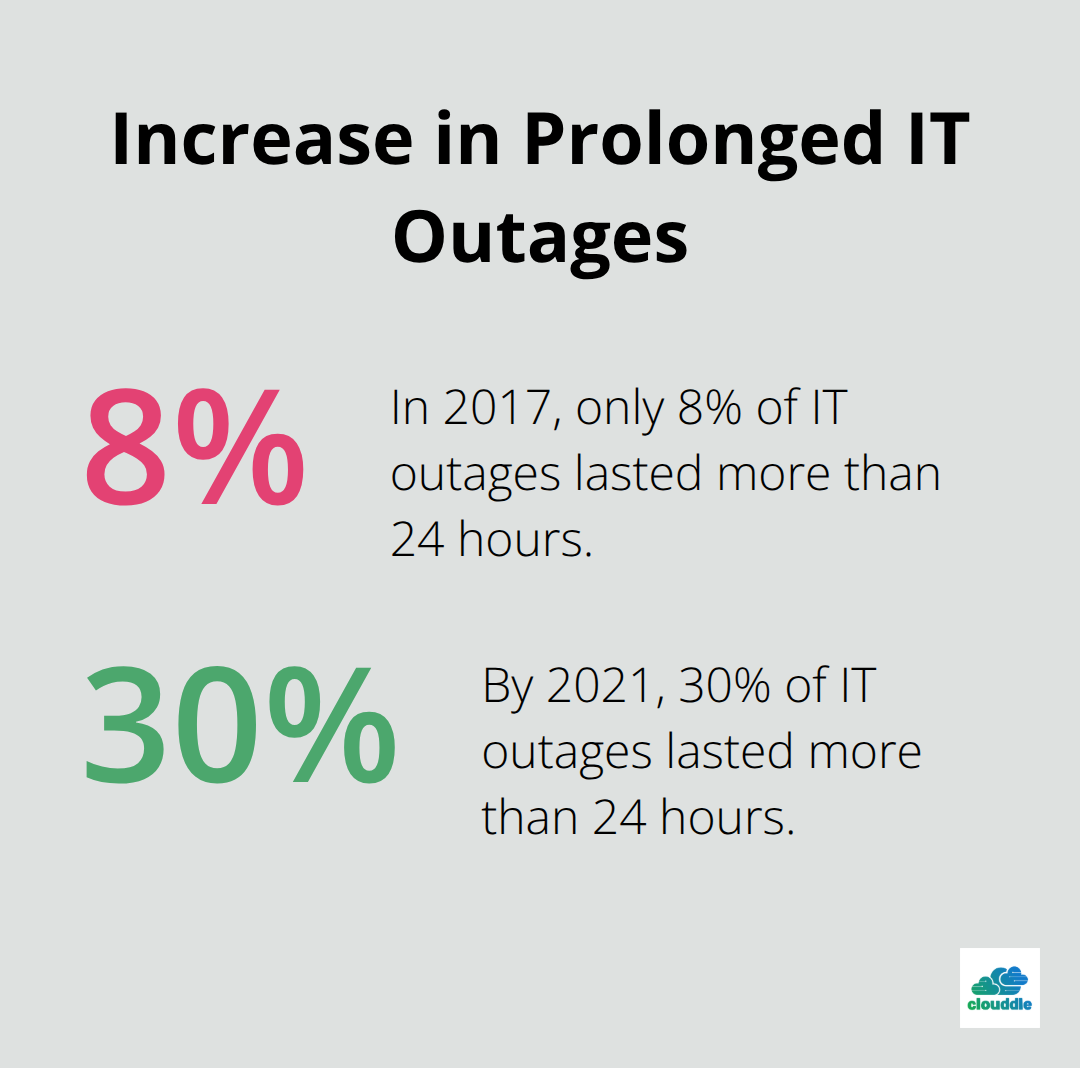Choosing the wrong IT service packages can cost your business thousands in downtime and lost productivity. Most companies struggle to match their technology needs with the right support model.
We at Clouddle see businesses make this mistake daily. The key lies in understanding your specific requirements before committing to any service agreement.
Which IT Service Package Fits Your Business
Break-Fix Support Creates Costly Risks
Break-fix support operates on a reactive model where you pay only when problems occur. This approach costs businesses an average of $10,000 per hour of downtime according to industry data, which makes it the most expensive option long-term. Small companies with minimal IT infrastructure might consider this model, but the unpredictable costs and extended response times make it unsuitable for businesses that depend on technology for daily operations. Most break-fix providers lack proactive monitoring, which leaves your systems vulnerable until failures happen.
Managed IT Services Transform Operations
Managed IT services provide comprehensive support through fixed monthly fees, typically reducing IT costs by up to 40% while improving operational efficiency. This model includes 24/7 monitoring, cybersecurity protection, and regular maintenance that prevents issues before they impact your business. Companies using managed services report significantly less downtime and stronger security postures. The predictable pricing structure allows better budget planning, while access to enterprise-level expertise gives small businesses technological capabilities they couldn’t afford independently.

Cloud Solutions Drive Modern Business
Cloud-based IT packages combine infrastructure, applications, and support into scalable solutions that grow with your business. These services eliminate the need for on-premises hardware maintenance and provide instant access to updated software and security features. Cloud solutions typically offer better disaster recovery capabilities and enable remote work flexibility that modern businesses require. The subscription-based pricing model converts large capital expenses into manageable operational costs, while automatic updates maintain security and performance without internal IT resources.
Network as a Service Revolutionizes IT Infrastructure
Network as a Service (NaaS) represents the latest evolution in IT service delivery, combining networking, security, and management into a single solution. This model eliminates upfront hardware investments while providing enterprise-grade infrastructure through monthly subscriptions. NaaS providers handle everything from installation to ongoing maintenance, which allows businesses to focus on core operations rather than technical complexities. The scalable nature of NaaS makes it particularly attractive for growing companies that need flexible technology solutions.
Now that you understand the different service models available, the next step involves evaluating what factors matter most for your specific business situation.
What Factors Drive Your IT Service Decision
Company Size Determines Service Requirements
Your company size directly determines which IT service model works best. Businesses with fewer than 20 employees typically spend around 5.49% of revenue on technology, while larger companies allocate 3-6% according to Deloitte research. Small businesses benefit most from managed services because they lack dedicated IT staff, whereas enterprises with 500+ employees often prefer hybrid models that combine internal teams with specialized external support. Your technical complexity matters more than headcount though. A 15-person fintech startup requires enterprise-grade security and compliance that costs significantly more than basic support for a retail store with similar staff numbers.
Budget Structure Shapes Service Selection
Fixed monthly costs work better than unpredictable break-fix expenses for most businesses. Managed services provide cost advantages compared to reactive support models, primarily because planned maintenance prevents expensive emergency repairs. Your budget should account for growth – cloud solutions scale automatically while on-premises systems require costly hardware upgrades. Calculate total cost of ownership over three years rather than focus on monthly fees alone. A $500 monthly managed service often costs less than $200 break-fix support when you factor in downtime expenses and productivity losses (which average $10,000 per hour according to industry data).

Industry Requirements Override General Preferences
Healthcare businesses must comply with HIPAA regulations, which requires specific encryption, audit trails, and incident response capabilities that basic IT support cannot provide. Financial services need SOX compliance and enhanced cybersecurity measures that add 30-50% to standard service costs. Manufacturing companies require 24/7 uptime and specialized industrial network management. Your industry dictates minimum security requirements – 43% of cyberattacks target small businesses according to Verizon’s Data Breach Report, which makes robust cybersecurity non-negotiable regardless of company size. Regulatory compliance failures cost businesses an average of $14.8 million annually per IBM studies.
Once you understand these fundamental factors, you need to evaluate potential providers based on their ability to meet your specific requirements and deliver reliable support.
How Do You Pick the Right IT Provider
Technical Expertise Separates Professionals from Amateurs
Certifications and technical expertise separate professional providers from amateur operations. Look for Microsoft Gold Partner status, Cisco certifications, and CompTIA credentials that demonstrate real competency. The best providers maintain multiple vendor certifications because modern businesses use diverse technology stacks. Check their experience with your industry – healthcare providers need HIPAA expertise while financial services require SOX compliance knowledge. Ask potential providers about their team qualifications and staff turnover rates, because high turnover means you lose relationship continuity and institutional knowledge about your systems.
Response Times Determine Business Continuity
Response time commitments determine how much downtime you experience during technical emergencies. Tier 1 issues should receive responses within 15 minutes, while routine requests can wait 4-8 hours according to industry standards. Avoid providers who promise unrealistic response times like instant support for all issues – they either lack proper staffing or set expectations they cannot meet. Verify their escalation procedures and after-hours coverage because 57% of IT outages occur outside business hours. Nearly 30% of these outages in 2021 lasted more than 24 hours, a disturbing increase from just 8% in 2017. Test their responsiveness during your evaluation process by submitting sample tickets and measuring actual response times versus promised service levels.

Contract Terms Protect Your Investment
Service level agreements define exactly what you receive for your monthly fees and establish penalties for provider failures. Strong SLAs include specific uptime guarantees of 99.9% or higher, which allows for roughly 43 minutes and 12 seconds of downtime each month, defined response times for different issue categories, and financial credits when providers miss targets. Avoid contracts with automatic renewal clauses longer than one year because your needs change rapidly in technology. Negotiate termination clauses that allow 30-60 day exits without penalties, especially important when switching providers due to poor performance. Review what happens to your data during contract termination – providers should guarantee secure data return within 30 days and complete system deletion afterward. Understanding managed services IT pricing models helps you evaluate whether contract terms align with industry standards and your budget expectations.
Final Thoughts
The right IT service packages align technology solutions with your specific business objectives and operational requirements. Your company size, industry regulations, and growth plans determine whether break-fix support, managed services, or cloud solutions work best for your situation. The investment decision extends beyond monthly costs to include downtime prevention, security protection, and productivity gains.
Managed services typically deliver the strongest return on investment for most businesses because they prevent expensive emergencies while providing predictable budgets. Implementation success depends on your choice of providers with proven expertise in your industry and clear service level agreements. Document your current technology challenges and future growth plans before you request detailed proposals from qualified providers.
We at Clouddle specialize in comprehensive technology solutions for hospitality, multi-family dwelling, and senior living industries. Our Network as a Service model eliminates upfront investments while providing enterprise-grade infrastructure with 24/7 support (which includes managed IT, networking, and security services). Contact us to discuss how our solutions can streamline your operations and support your business growth objectives.


